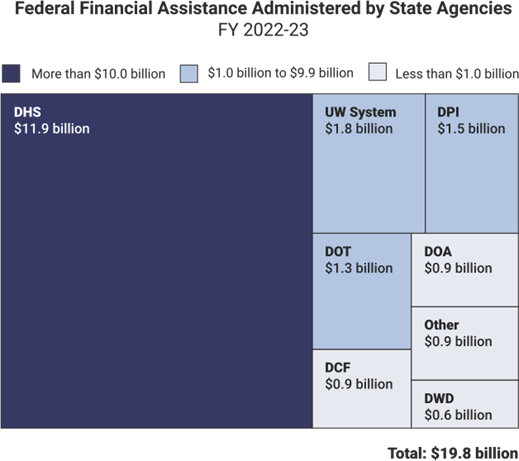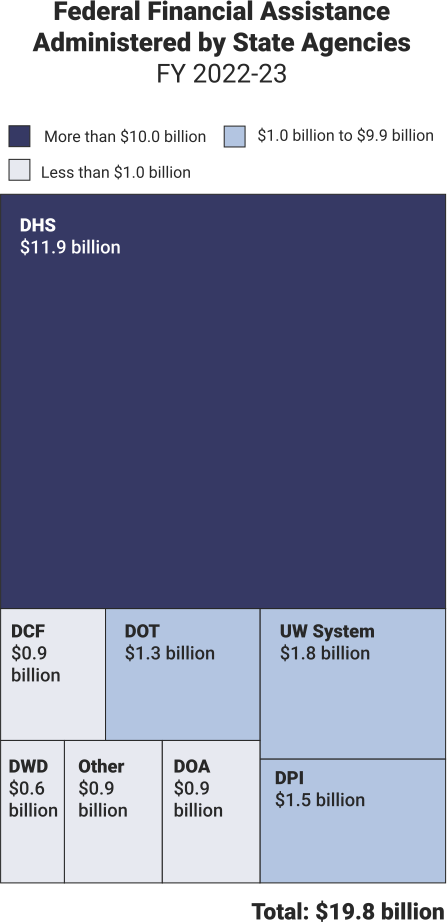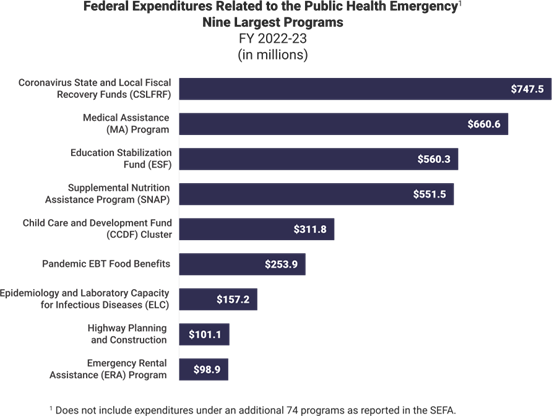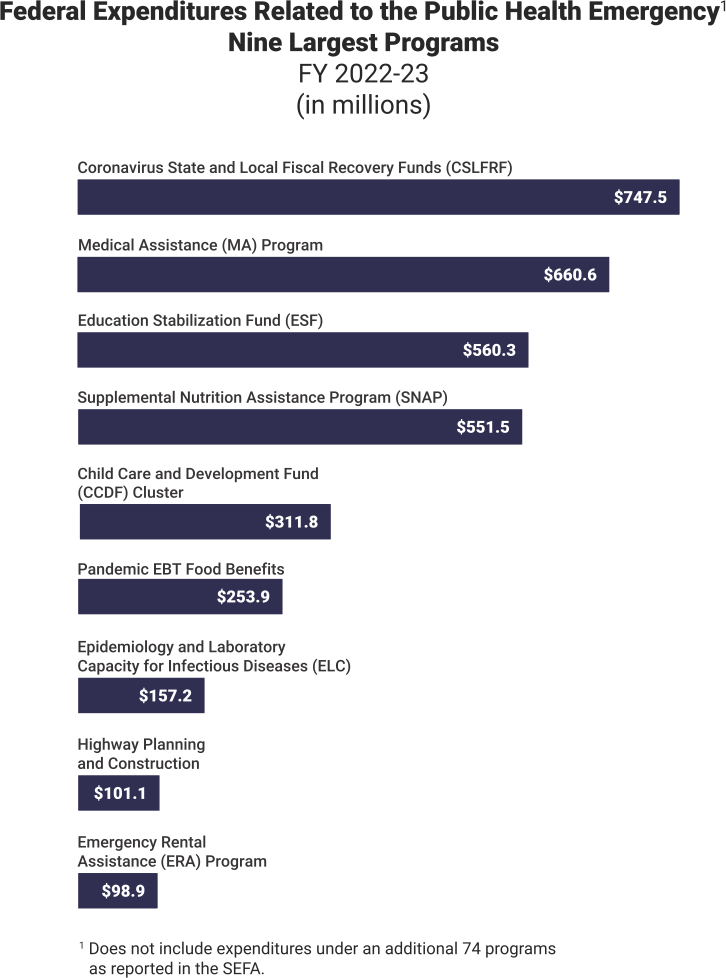As a condition of receiving federal funds, state agencies must meet the audit requirements of the federal Office of Management and Budget Uniform Administrative Requirements, Cost Principles, and Audit Requirements for Federal Awards (Uniform Guidance), and the Single Audit Act of 1984, as amended. The Single Audit Act requires there to be one comprehensive audit of federal programs.
Report 24-3 focused on 22 federal programs that accounted for 61.2 percent of the federal financial assistance administered by state agencies in fiscal year (FY) 2022-23. This single audit also incorporates our annual audit of the State’s FY 2022-23 financial statements. These financial statements were included in the State's Annual Comprehensive Financial Report (ACFR) issued in December 2023 by the Wisconsin Department of Administration (DOA).
We provided an unmodified opinion on federal compliance for 16 of the programs we reviewed. However, we qualified our opinion on compliance for certain requirements for six of the programs we reviewed. An auditor provides a qualified opinion on compliance when the compliance concerns are material in relation to a specific compliance area tested for a federal program or cluster.
The federal financial assistance administered by state agencies during FY 2022-23 included $17.3 billion in cash assistance, $2.4 billion in noncash assistance, and $59.8 million in outstanding loan balances. Seven agencies administered 95.3 percent of the federal expenditures during FY 2022-23: the Department of Health Services (DHS), the University of Wisconsin (UW) System; Department of Public Instruction (DPI), Department of Transportation (DOT), Department of Children and Families (DCF), DOA, and the Department of Workforce Development (DWD).


The State was required to separately identify the federal funding it expended related to the public health emergency, including funding provided under the Coronavirus Aid, Relief, and Economic Security (CARES) Act and the American Recovery Plan Act (ARPA). In its Schedule of Expenditures of Federal Awards (SEFA), the State reported that it spent $3.8 billion through federal programs or clusters for purposes related to the public health emergency. The largest portion of these expenditures was $747.5 million for the Coronavirus State and Local Fiscal Recovery Funds (CSLFRF) program. These federal expenditures also included spending through the Medical Assistance (MA) Program, the Education Stabilization Fund, the Supplemental Nutrition Assistance Program (SNAP), the Child Care and Development Fund (CCDF) Cluster, Pandemic EBT Food Benefits, the Epidemiology and Laboratory Capacity for Infectious Diseases (ELC) program, the Highway Planning and Construction program, and the Emergency Rental Assistance (ERA) Program.


An auditor provides a qualified opinion on compliance when the compliance concerns are material in relation to a specific compliance area tested for a federal program or cluster. We qualified our opinion on compliance related to various compliance requirements for six federal programs, including:
- the ERA Program administered by DOA;
- the Children’s Health Insurance Program (CHIP) administered by DHS;
- the Social Services Block Grant program administered by DHS;
- the Activities to Support State, Tribal, Local and Territorial (STLT) Health Department Response to Public Health or Healthcare Crises program administered by DHS;
- the Public Health Emergency Response: Cooperative Agreement for Emergency Response: Public Health Crisis Response program administered by DHS; and
- the Geographic Programs - Great Lakes Restoration Initiative program administered by the Department of Natural Resources (DNR).
We have reported concerns with DOA’s administration of the ERA Program since its inception in FY 2020-21. In both our performance evaluation of the ERA Program (report 22-3) and in our FY 2020-21 single audit (report 22-5), we identified concerns with DOA’s administration of the program. We also identified continued concerns as part of our FY 2021-22 single audit (report 23-4) and recommended that DOA make improvements.
As part of our FY 2022-23 single audit, we again qualified our opinion on compliance related to the eligibility requirements for the ERA Program. Although we noted some improvements in documentation related to eligibility determinations, we continued to identify concerns. This year, we also reported findings related to DOA’s monitoring of the nonprofit organizations that assist DOA in administering this program, and qualified our opinion on compliance related to DOA’s subrecipient monitoring efforts.
CHIP provides financial assistance to states to maintain and expand health care coverage for children residing in low-income families. Children under age 19 are eligible to participate in the program. Throughout the public health emergency, DHS maintained health care coverage for certain participants who were age 19 or older. We identified 8,996 participants who were age 19 or older who received benefits in FY 2022-23. We questioned $12,706,113, representing the federal share of benefits paid for these individuals. We recommended DHS work with the federal government to resolve these improper payments.
State agencies provide funding through a subaward to local governments, nonprofit organizations, and other entities to carry out a federal program on behalf of the agency. In these cases, the state agency retains responsibility for ensuring the federal award is carried out in accordance with federal rules and regulations. To do this, state agencies conduct monitoring through review of reports and expenditure documentation, and on-site visits to the entity, as determined appropriate.
As part of our FY 2022-23 audit, we identified concerns with these monitoring procedures for 7 of the 22 major programs audited at four state agencies, including DOA, DCF, DHS, and DNR.
Under the requirements of the Federal Funding Accountability and Transparency Act (FFATA) of 2006, state agencies are required to report subawards of $30,000 or more in the FFATA Subaward Reporting System (FSRS). Information that is reported in FSRS is publicly available on USASpending.gov. State agencies are required to complete the reporting for federal grant programs subject to the reporting requirement. DOA completes FFATA reporting for certain state agencies.
We identified seven findings related to FFATA reporting involving 11 of the major programs audited at five state agencies, including DOA, DHS, DWD, DCF, and the Department of Justice (DOJ). In addition, we recommend DOA improve the accuracy of reporting on USASpending.gov by changing its reporting of subaward modifications to follow FSRS guidance and providing guidance and training to state agencies.
Our 60 recommendations pertained to 28 findings, including 3 findings related to internal control deficiencies we identified in our audit of the State’s ACFR (report 23-26). We consider 8 of the findings to be material weaknesses and 17 to be significant deficiencies. The remaining three findings were related to other matters that did not have a related material weakness or significant deficiency.
| Type of Finding | ||||
| Agency | Material Weakness1 | Significant Deficiency2 | Other3 | Total |
| DOA | 3 | 6 | 1 | 10 |
| DHS | 4 | 5 | 1 | 10 |
| DCF | 3 | 3 | ||
| DNR | 1 | 1 | ||
| DPI | 1 | 1 | ||
| DWD | 1 | 1 | ||
| DOJ | 1 | 1 | ||
| DOT | 1 | 1 | ||
| Total | 8 | 17 | 3 | 28 |
| Recommendations |
| 23 |
| 23 |
| 6 |
| 4 |
| 1 |
| 1 |
| 1 |
| 1 |
| 60 |
1 A material weakness is a deficiency, or a combination of deficiencies, in internal control over compliance or financial reporting, such that there is a reasonable possibility that a material misstatement or material noncompliance will not be prevented or detected and corrected on a timely basis.
2 A significant deficiency is a deficiency, or a combination of deficiencies, in internal control over compliance or financial reporting that is less severe than a material weakness in internal control, yet important enough to merit attention by those charged with governance.
3 A noncompliance finding that does not have a related material weakness or significant deficiency.
We also questioned $13.0 million in expenditures that state agencies charged inappropriately to federal funds. These questioned costs relate to the CHIP, CSLFRF, the ERA Program, and the Homeowner Assistance Fund.
| Federal Program | Questioned Costs | |||
| Children's Health Insurance Program | $ 12,706,113 | |||
| Coronavirus State and Local Fiscal Recovery Funds | 266,723 | |||
| Emergency Rental Assistance Program | 15,056 | |||
| Homeowner Assistance Program | 10,886 | |||
| Total | $12,998,778 | |||
Finally, we followed up on the progress of state agencies to address recommendations we made in our FY 2021-22 single audit report (report 23-4). The federal government will work with state agencies to resolve the new and continuing concerns we identified.
| Type of Finding | ||||
| Agency | Material Weakness1 | Significant Deficiency2 | Other3 | Total |
| DOA | 3 | 6 | 1 | 10 |
| DHS | 4 | 5 | 1 | 10 |
| DCF | 3 | 3 | ||
| DNR | 1 | 1 | ||
| DPI | 1 | 1 | ||
| DWD | 1 | 1 | ||
| DOJ | 1 | 1 | ||
| DOT | 1 | 1 | ||
| Total | 8 | 17 | 3 | 28 |
1 A material weakness is a deficiency, or a combination of deficiencies, in internal control over compliance or financial reporting, such that there is a reasonable possibility that a material misstatement or material noncompliance will not be prevented or detected and corrected on a timely basis.
2 A significant deficiency is a deficiency, or a combination of deficiencies, in internal control over compliance or financial reporting that is less severe than a material weakness in internal control, yet important enough to merit attention by those charged with governance.
3 A noncompliance finding that does not have a related material weakness or significant deficiency.
| Recommendations | ||
| DOA | 23 | |
| DHS | 23 | |
| DCF | 6 | |
| DNR | 4 | |
| DPI | 1 | |
| DWD | 1 | |
| DOJ | 1 | |
| DOT | 1 | |
| Total | 60 | |
We also questioned $13.0 million in expenditures that state agencies charged inappropriately to federal funds. These questioned costs relate to the CHIP, CSLFRF, the Emergency Rental Assistance Program, and the Homeowner Assistance Fund.
| Federal Program | Questioned Costs | |||
| Children's Health Insurance Program | $ 12,706,113 | |||
| Coronavirus State and Local Fiscal Recovery Funds | 266,723 | |||
| Emergency Rental Assistance Program | 15,056 | |||
| Homeowner Assistance Fund | 10,886 | |||
| Total | $12,998,778 | |||
Finally, we followed up on the progress of state agencies to address recommendations we made in our FY 2021-22 single audit report (report 23-4). The federal government will work with state agencies to resolve the new and continuing concerns we identified.




